This checklist can be applied to any site built with Squarespace to increase your traffic and search engine rankings as quickly as possible.
You certainly will not be able to go through this step-by-step Squarespace SEO checklist in a single day, and that’s OK.
Download the PDF version below so you can keep track of what is done over the next few days.
Get this Sqaurespace SEO checklist sent to your inbox
Squarespace SEO Overview
First, let’s go over the mandatory tools and plugins you’ll need to optimize your Squarespace sites.
Set Up Google Tag Manager
Although it’s not strictly an SEO tool, Google Tag Manager (GTM) will make your life easier as a digital marketer.
With GTM, you can easily deploy code on your site—which you’ll need to set up other tools on this Squarespace SEO checklist—without needing to learn how to code or contact a developer.
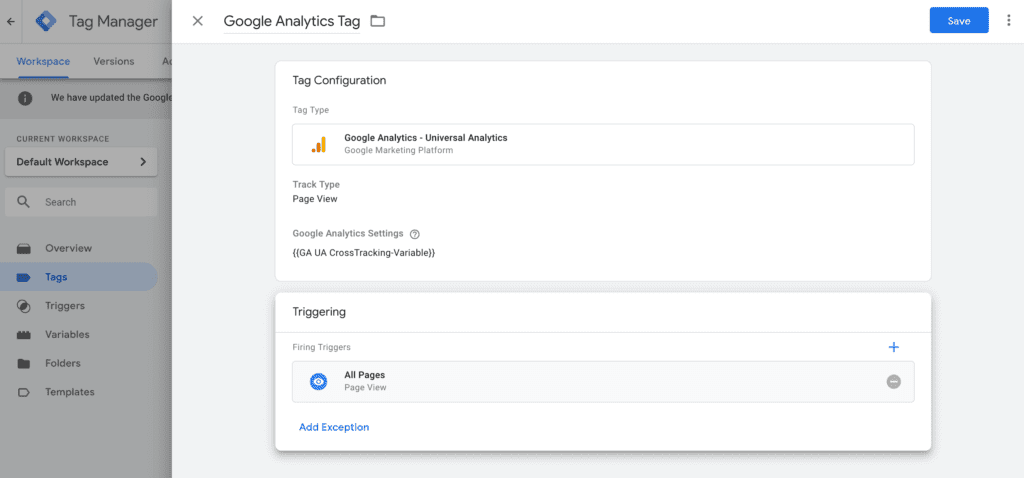
Google Tag Manager is simple:
- Select the type of code you want to add (this includes some pre-built options like Google Analytics)
- Add code details (e.g. for Google Analytics, just add your tracking ID)
- Choose where to trigger the code
- Publish your changes—the new code will be automatically added to your Squarespace site.
Here’s a simple guide to help you set up Google Tag Manager:
Set Up Google Search Console
Search Console is a free webmaster tool created by Google for website owners. It provides useful data about your website’s performance in Google’s search results.
For example:
- Which keywords are generating the most clicks
- What’s the click-through rate of your content in the search results
- How your keyword rankings have changed over time
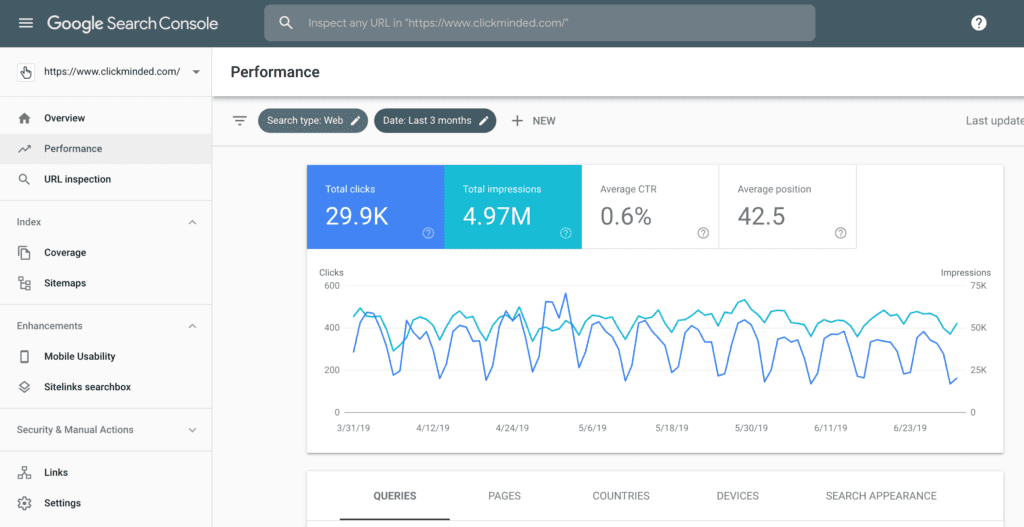
Plus, Search Console is useful to perform technical SEO tasks like:
- Request crawling and indexing of your website’s pages
- Submit your website’s sitemap to Google
- Check your robots.txt file for errors
Finally, Search Console is how you get communications from Google about:
- Website errors (mobile-friendliness, indexation, etc)
- Manual penalties
Search Console is a must-have tool for your Squarespace site.
Here’s a resource to help you set up Google Search Console:
Install Google Analytics
If you haven’t installed Google Analytics yet—stop everything else you’re doing and do this instead.
With Google Analytics you’ll be able to determine how your SEO efforts are impacting the performance of your website.
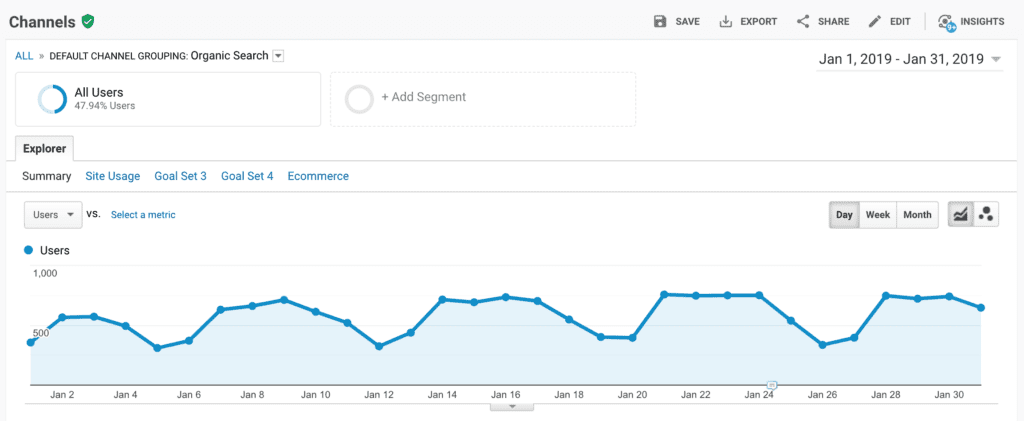
You can use Google Analytics to learn things like:
- How much conversions or revenue you’re getting from SEO
- Which blog posts or web pages are attracting the most organic traffic
- What’s the conversion rate of your organic traffic
- Demographic insights about your users
Plus, you can connect Google Search Console to Google Analytics and perform analysis that mixes both data sources.
Here are some resources to help you set up Google Analytics:
- How to Add Google Analytics to Squarespace: A Beginner’s Guide
- Configuring Search Console data in Google Analytics
Keyword Research
Keyword research is the most important element of SEO. You need to have a solid keyword strategy before you even start optimizing your Squarespace site.
Learn the Basics of Keyword Research
Keyword research is the process of understanding what people are searching for in Google, Bing, and other search engines.
You can use keyword research to discover massive opportunities, prioritize your content plan, and even make budget decisions.
To do this, you just need to understand 3 concepts: search volume, keyword difficulty, and searcher intent.
Search volume is an estimate of how many times a search term (keyword) is searched for each month.
Search volumes allow you to compare search keywords based on how popular they are. You can use this information to know what to write and NOT write about.

For example, if you have a blog about tennis, keyword research would allow you to know that it’s a much better idea to write a post about “tennis tips” than about “tennis techniques”.
Keyword difficulty is a calculation offered by some tools about how easy (or difficult) it is to rank for a certain search term.
You can use keyword difficulty as a second filter for the target keywords you select.

For example, let’s say you run a website that reviews sports apparel. If you relied exclusively on search volume to prioritize your search keywords, you would choose to pursue “soccer cleats” over “football cleats”—after all, it has 65% more searches per month. However, it’s almost 3 times more difficult to rank “soccer cleats” than it is to rank “football cleats”.
If you’re running a small business website, it will be easier and faster for you to get Search Engine Optimization or SEO traffic for “football cleats”.
Searcher intent refers to figuring out what the user was looking for when they typed a specific keyword into Google. This sounds obvious but it can save you from wasting a lot of time and effort.

If you own a website about baseball and looked at the data above, it would look like a great opportunity to create a page dedicated to baseball bats made of metal, right?
However, when you look at the search for the search term “metal bat”, all the results are about a character from an anime series.
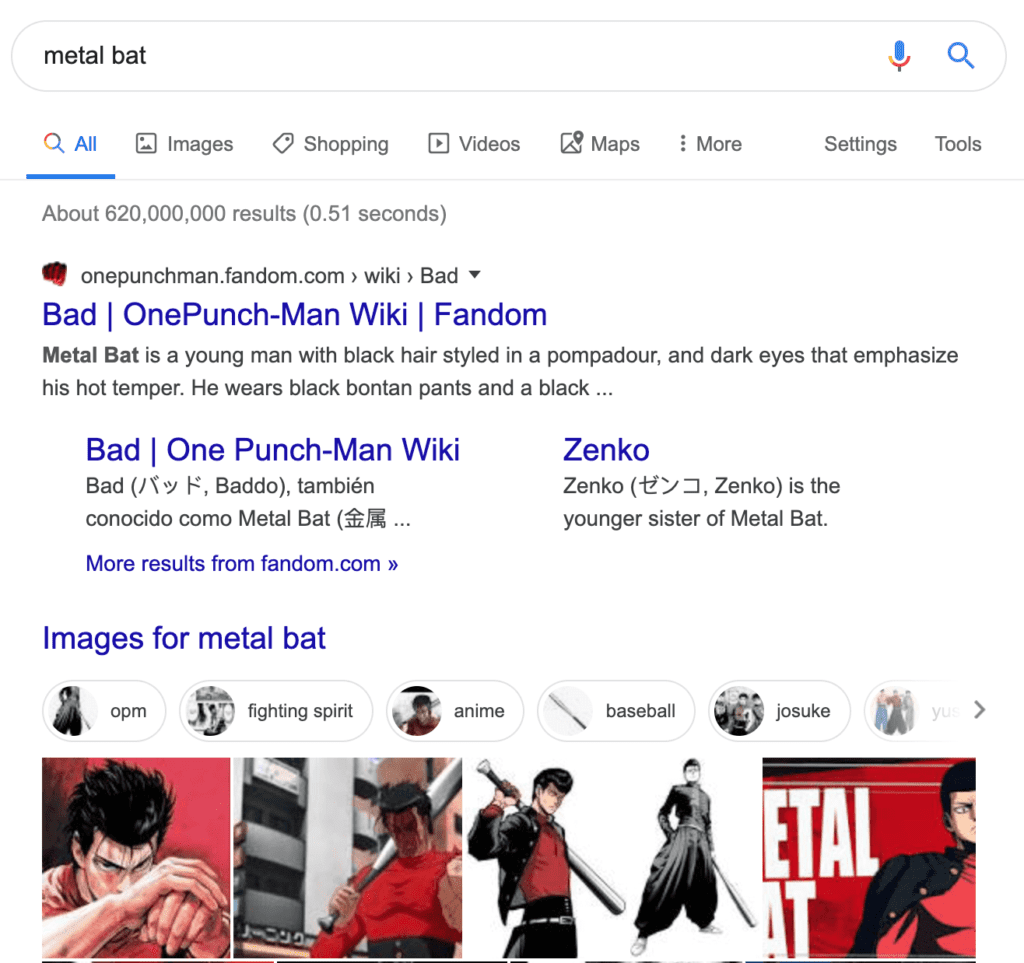
This simple check tells you that you probably won’t be able to rank for that term, and even if you did, people looking for “metal bats” are not looking for baseball bats.
Use a Keyword Research Tool
For years, people relied on Google’s Keyword Planner to perform keyword research.
However, it has become unfriendly and less reliable in the last few years. Most SEOs today rely on third-party tools instead.
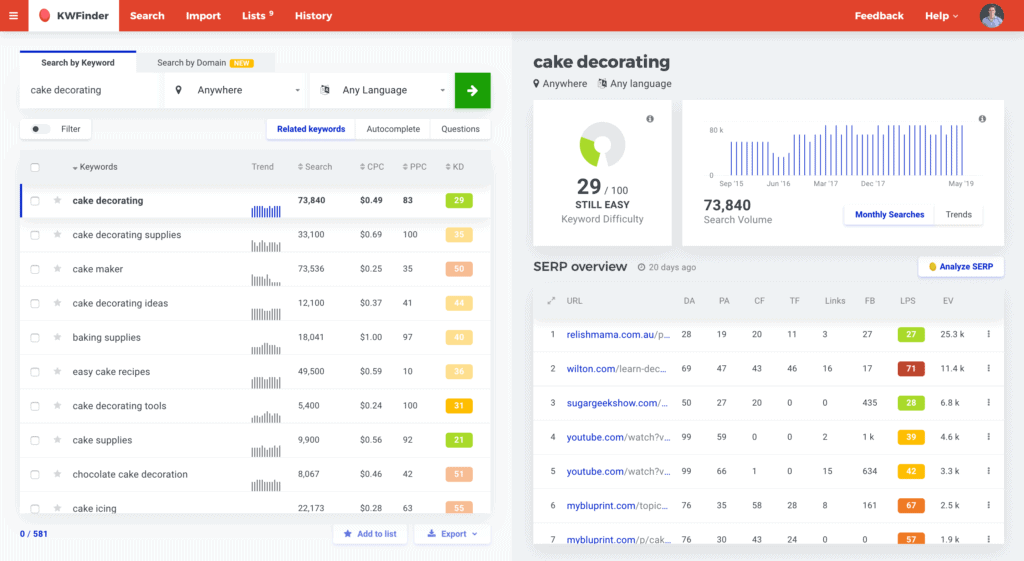
Our favorite tools at ClickMinded are KWFinder (affiliate link) and ahrefs—both of these include:
- Search volumes, seasonality, keyword difficulty
- Related keywords, autocomplete/search suggestions (what happens when you start typing something in Google), questions
- Find out who is currently ranking for the target keywords you are looking for
Map Your Keywords Against Your Sales Funnel
Different keywords will serve different purposes for your business. This depends on which part of your sales funnel each target keyword belongs to.
Top of the funnel keywords will typically have higher search volumes but have less commercial intent behind them. People searching for these terms are just looking for information and are not necessarily ready to buy.
Keywords at the middle of the funnel have less volume than the top of the funnel keywords, but people searching for these terms are already considering their options for products, sellers, or brands.
Keywords at the bottom of the funnel usually have the lowest search volume but high commercial intent. People searching for these terms are ready to become customers. Your keyword strategy should look to balance keywords for each stage of the funnel.
Top of the funnel keywords will attract most of your traffic, while the bottom of the funnel keywords will generate the most revenue for your business.
Here’s how you might map some keywords against the sales funnel of a website selling tea.

If you didn’t do this, you might be tempted to dismiss some keywords with lower search volumes until you realize that they are more likely to convert visitors into customers.
Here are some resources to help you understand keywords and the sales funnel:
- The ClickMinded SEO Strategy Guide
- The ClickMinded Sales Funnel Strategy Guide
- The ClickMinded Keyword Strategy Masterclass
Avoid Keyword Cannibalization
Keyword cannibalization happens when several blog post URLs or web pages on your site are competing for the same target keyword.
You should target each keyword (and related search terms) with a single URL or page.
For example, if you have a blog post that’s ranking for the keyword “best organic coffee” and attracting good traffic, you should avoid optimizing another page for the same keyword.
On-Page SEO
Google algorithm can’t understand content as easily as humans. On-page optimization is the process of helping search engines understand what your content is about to get higher rankings.
Include Your Target Keyword in the URL
This is the first thing Google sees—even before the content of your page.
In fact, Google has started to give more relevance to URLs by moving them to the top of each search result.
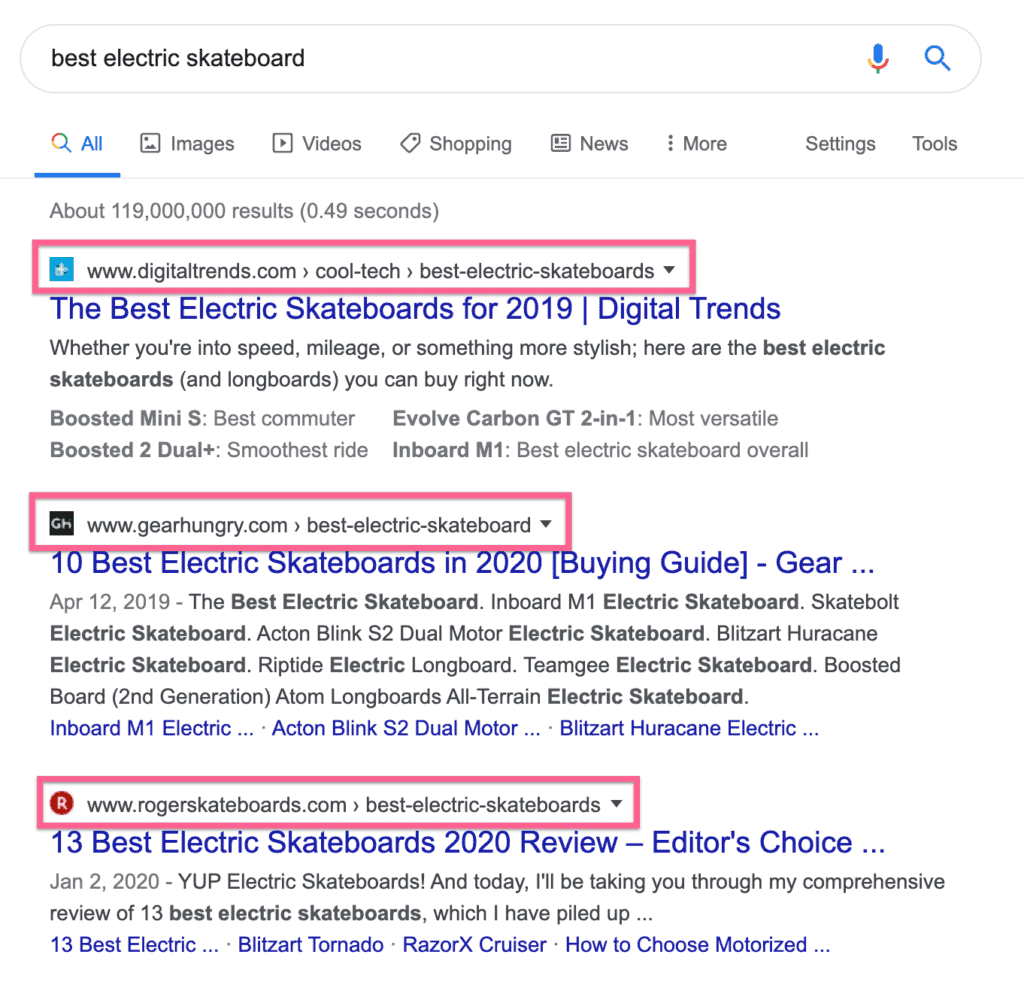
When you include your target keyword in the page URL, you’re sending Google a signal of what your page is about.
If you are creating a page about red running shoes, a good example would be to use: www.yourwebsite.com/red-running-shoes.
A bad example would be something like www.yourwebsite.com/post/2981-1, which doesn’t give us (or search engines) any clue of what the web page content is about.
To optimize your URLs, you should:
- Include the target keyword in the post URL
- Avoid using stop words like “the” or “and” in the URL slug
- Keep the URLs short
Warning: There are very serious consequences to changing a URL that already has authority. Don’t do this if your page already has links!
You can edit your URLs in Squarespace in the “Options” tab while editing your pages or posts:
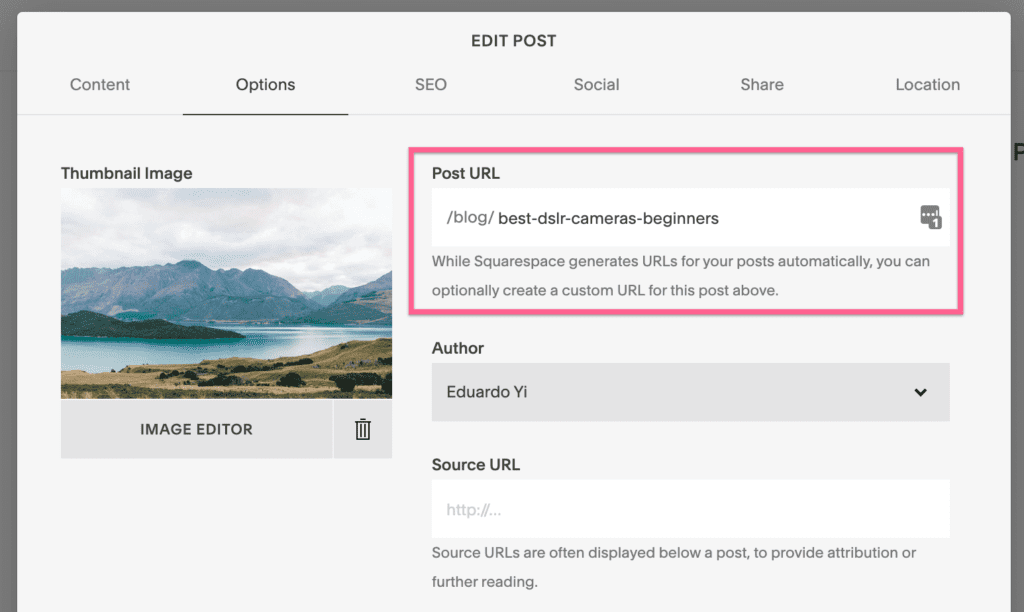
Keep Your URLs Short
It can be tempting to stuff your URLs with as many keywords as possible—avoid this!
Research has shown that shorter URLs tend to rank higher than long ones.
- Good example: www.yourwebsite.com/red-running-shoes
- Bad Example: www.yourwebsite.com/cheap-red-running-shoes-nike-shoes-discount
Here’s a helpful article on how to optimize your URLs:
Add Your Keyword to Your Title Tag
Title tags are still one of the most powerful important elements of on-page SEO.
The site title tag is what people will see when they search on Google.
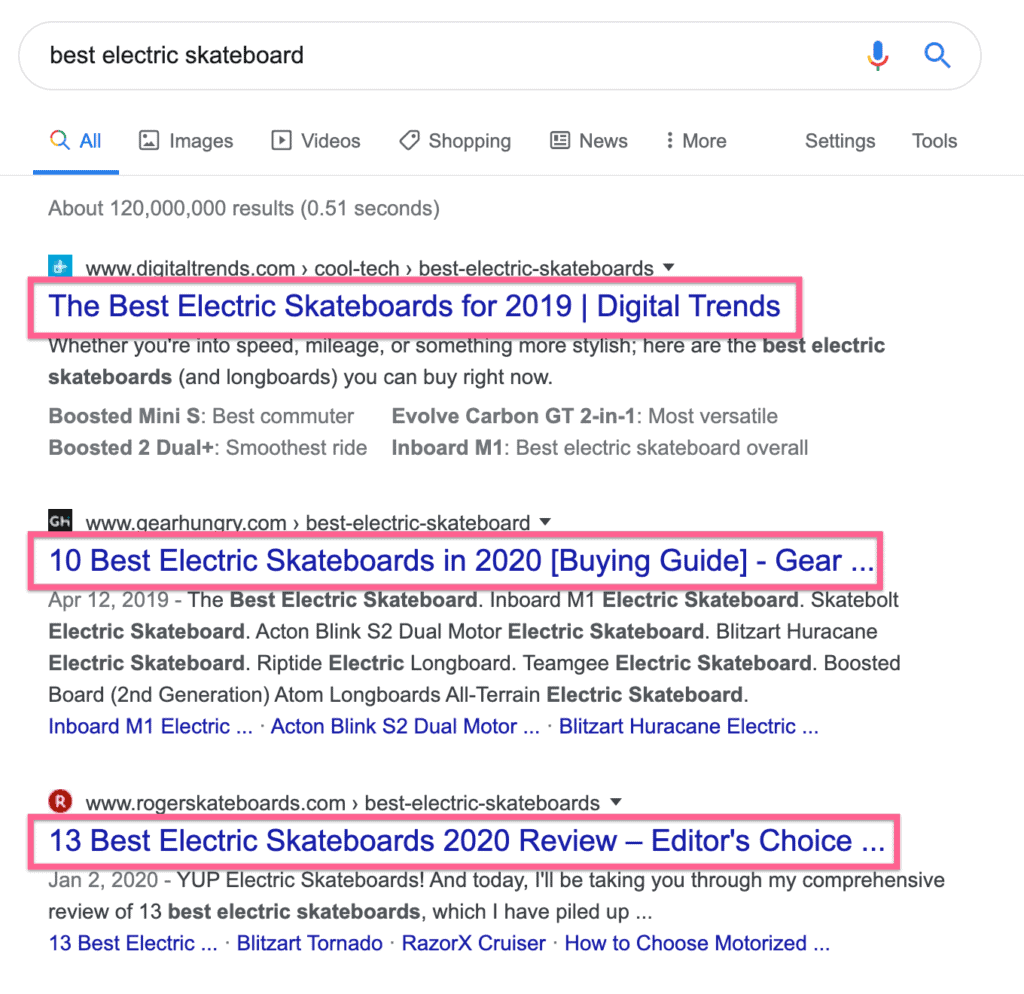
That’s why you should include your target keyword in the title tag.
In Squarespace, you can edit your page title in the SEO tab while editing your pages or posts.
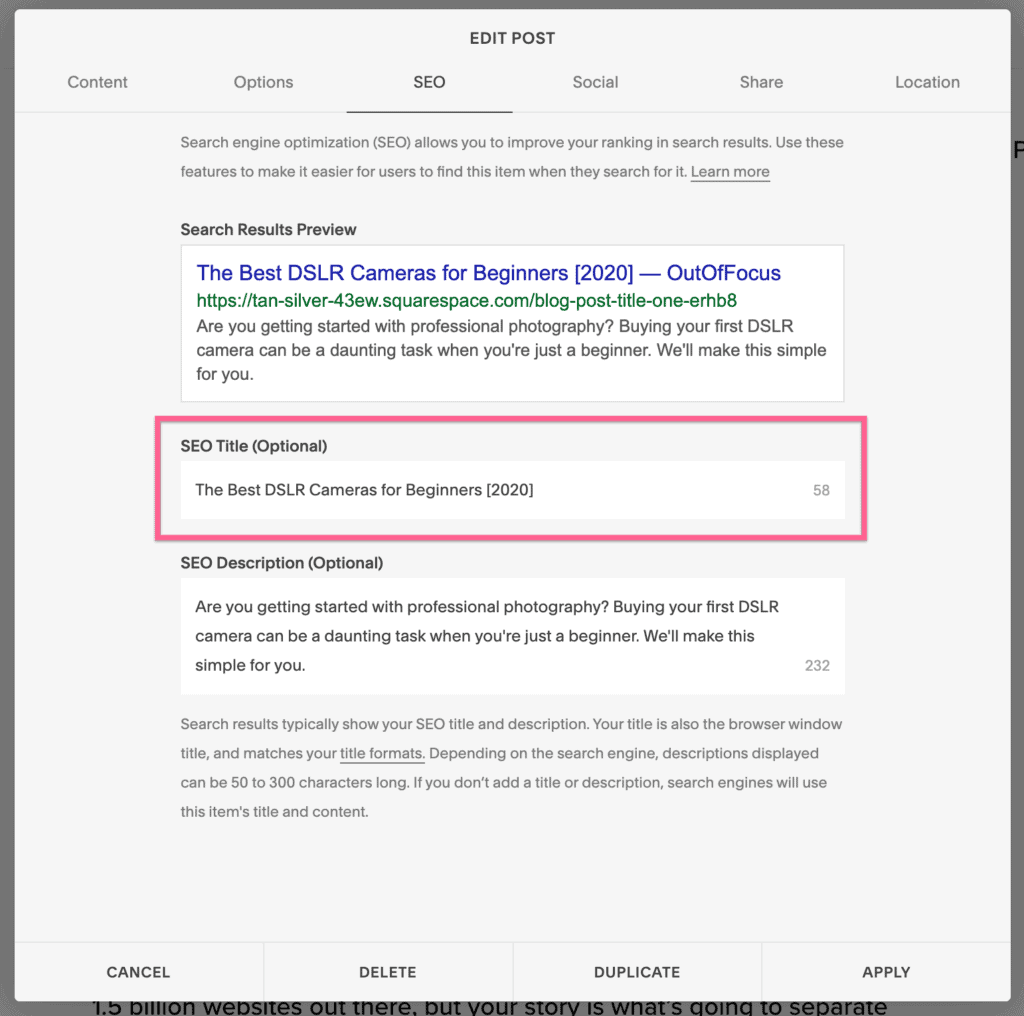
In general, try to include your keyword closer to the beginning of the sentence and keep the entire title under 52 characters.
Here’s a great resource to help you optimize your title tags and create an SEO title.
Optimize Your Title for Organic CTR
If more people click on your page vs other websites in the search engine results page, it gives Google bots an indication that your page might be a better answer to people’s queries than those other sites.
This is called organic clickthrough rate (CTR): the percentage of people who click on your page divided by everyone who sees it.
That’s why it’s not enough to just include the keyword in there. Your title tag needs to be eye-catching and entice searchers to click on it.
A good idea when crafting your title is to look at what your competitors are doing…
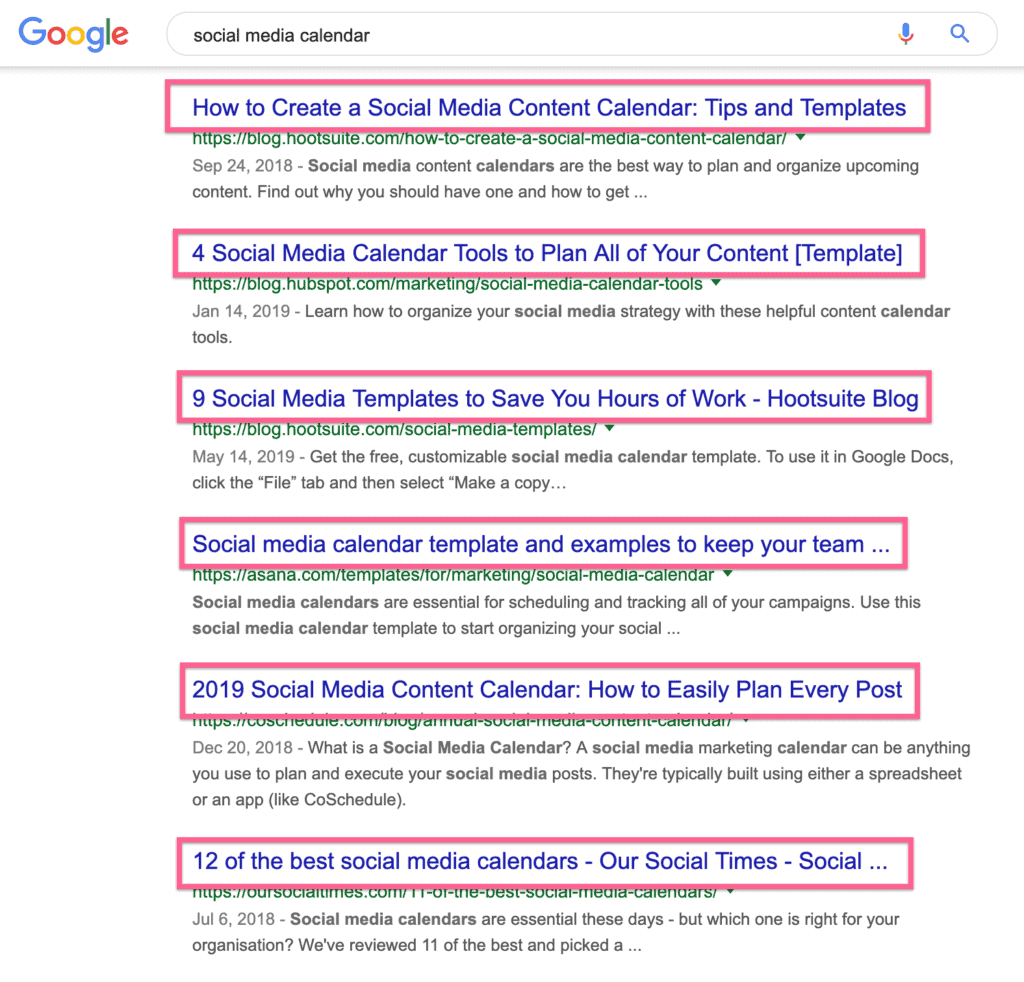
…and come up with something better.
Some best practices include:
- Use an active voice
- Write in the second person
- Use power words
- Use numbers, brackets, or parentheses
- Include the date (month or year)
Use Google Search Console to find and track the CTR of your pages for target keywords.
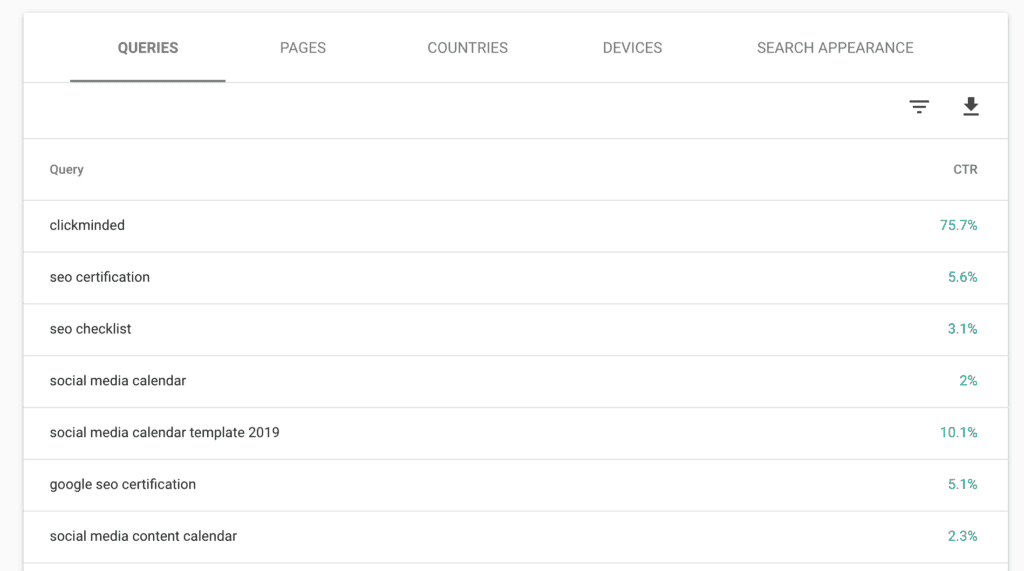
Here are some resources to help you increase the CTR of your title tags:
- CoSchedule’s Headline Analyzer
- How To Optimize Your Website’s HTML Title Tag For More Traffic
- 401+ Ridiculously Useful Power Words To Increase Conversions
Add Your Keyword to Your Meta Description and Make it Compelling
The meta/seo description is the snippet of text that appears in search results below the page title.
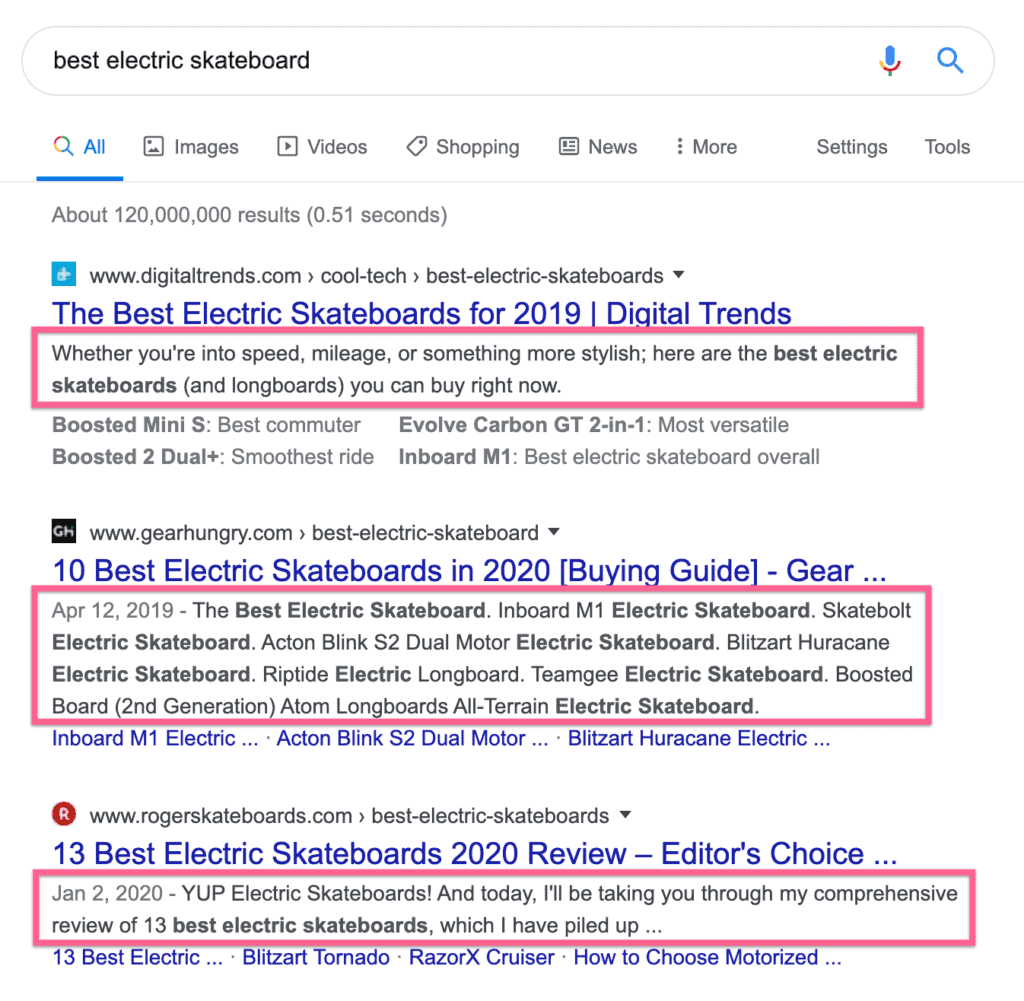
Even though the meta description is no longer a ranking factor, it can indirectly help you get higher rankings by increasing your CTR. Plus, Google highlights the keyword the user searched if it’s included in the meta description.

In your Squarespace site, you can edit your meta descriptions in the SEO tab while editing your pages or posts.
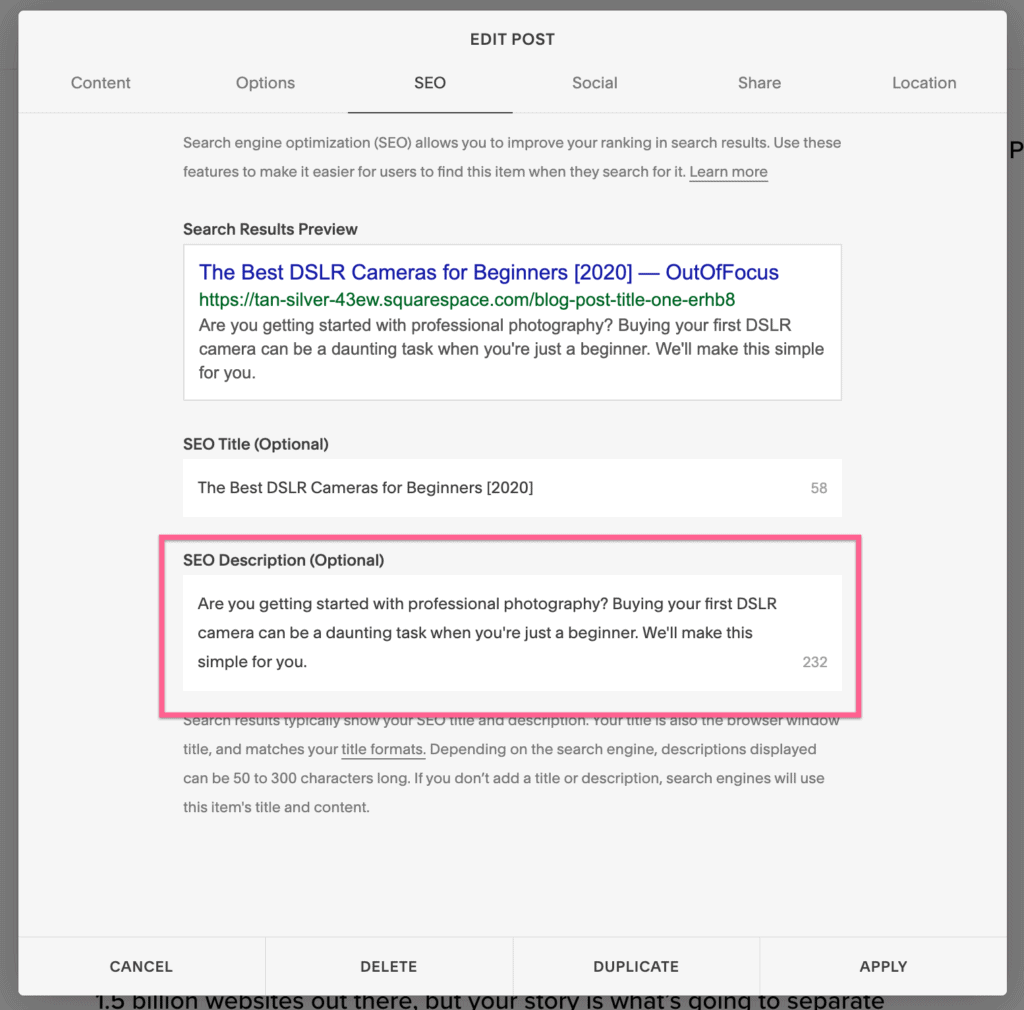
Here are some resources to help you optimize your meta descriptions:
- Meta Description Tag: Optimizing Your CTR for More Clicks & More Traffic
- This is a helpful article about meta descriptions
Include Your Keywords in the Copy of Your Pages
This one’s pretty straightforward. Include your keywords in the site description of the page you’re optimizing.
We recommend including the keyword in the h1 heading of the page and again in the body near the top of the page.
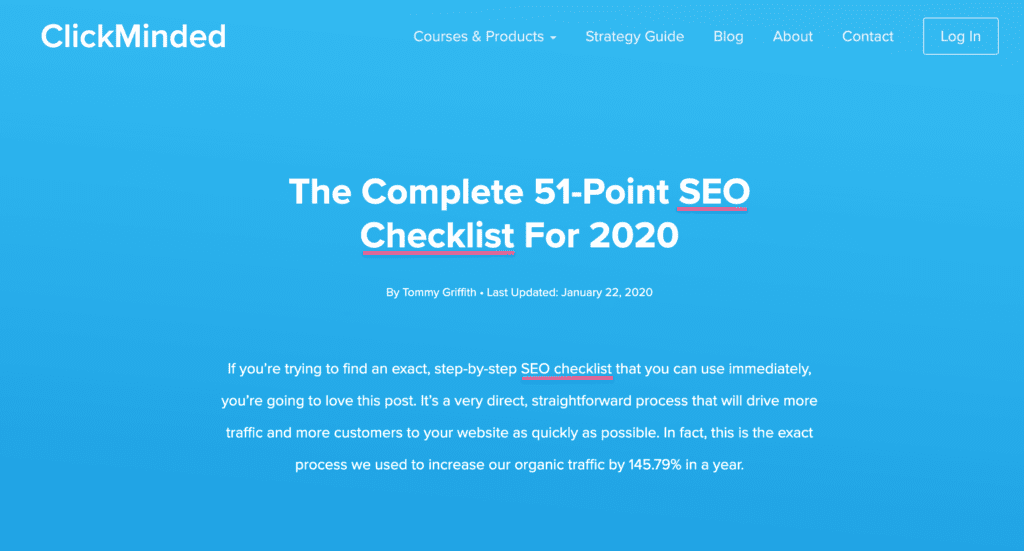
Don’t overdo it, though. Getting your exact keyword in there 2 or 3 times is probably good enough.
Try reading your text out loud—if it sounds weird, then you should probably dial it down a bit.
Include Synonyms and LSI Keywords in Your Text
Aside from including your exact keyword, it’s helpful to throw in some synonyms and LSI keywords. Both help provide more context to search engines about what’s the topic of a page.
LSI keywords are terms that are thematically related to a keyword.
For example, a synonym of “NYC” could be “New York City” and an LSI keyword could be “Empire State Building” or “Statue of Liberty”.
To find synonyms or LSI keywords, you can use Thesaurus and LSIGraph.
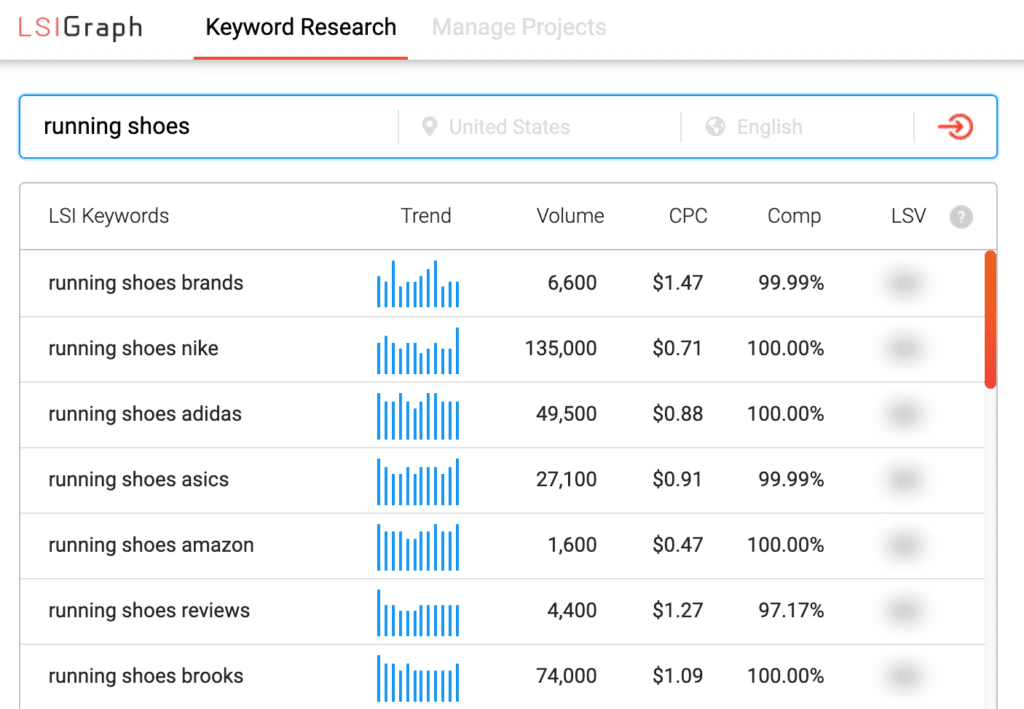
Optimize Your Pages for Higher Engagement
Google’s entire business model relies on being able to provide relevant results to people’s searches. That’s why a lot of SEOs believe that Google has started to use engagement metrics to help determine whether a piece of content is relevant to a searcher or not.
It’s simple: if a searcher spends time on your page and interacts with it, Google can assume that the information shown to that user was relevant.
Some best practices to optimize the engagement of your content include:
- Writing short sentences instead of long paragraphs
- Organizing your content with headings and subheadings
- Including rich media like images, gifs, audio, and video
- Linking to additional helpful resources
For example, we followed these guidelines for our email marketing strategy guide:
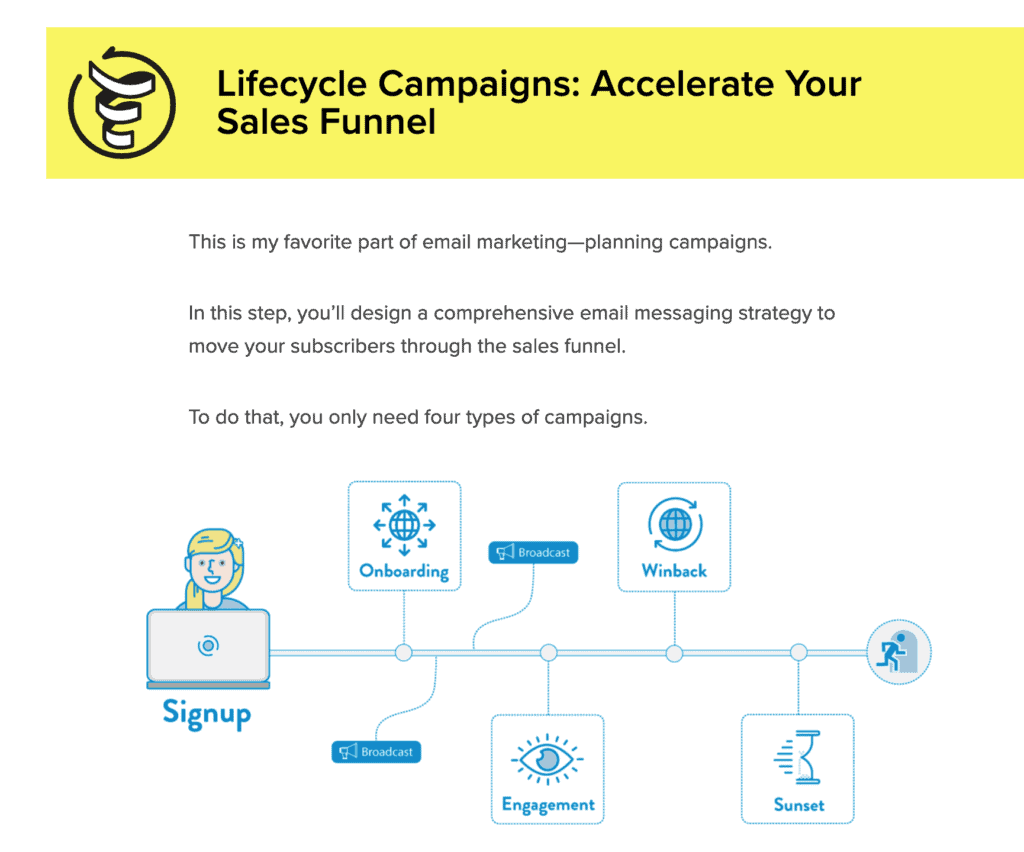
And received great feedback from our readers:

Here are some resources to help you write better content:
- To learn more about creating great, engaging content that converts visitors into customers, check out our content marketing training course
- Hemingway Editor
- Grammarly
Optimize Your Images
Search engines “see” images by reading the ALT tag and looking at file names, among other factors.
Optimizing the images in your Squarespace store is a 2-step process.
First, use a descriptive name for the image file before you upload it to your site.
- Bad filename: img-190303.png
- Good filename: womens-white-shirt.png
Second, edit the alt text of your image file inside the Squarespace admin—the best practice is to write a short SEO description of the image.
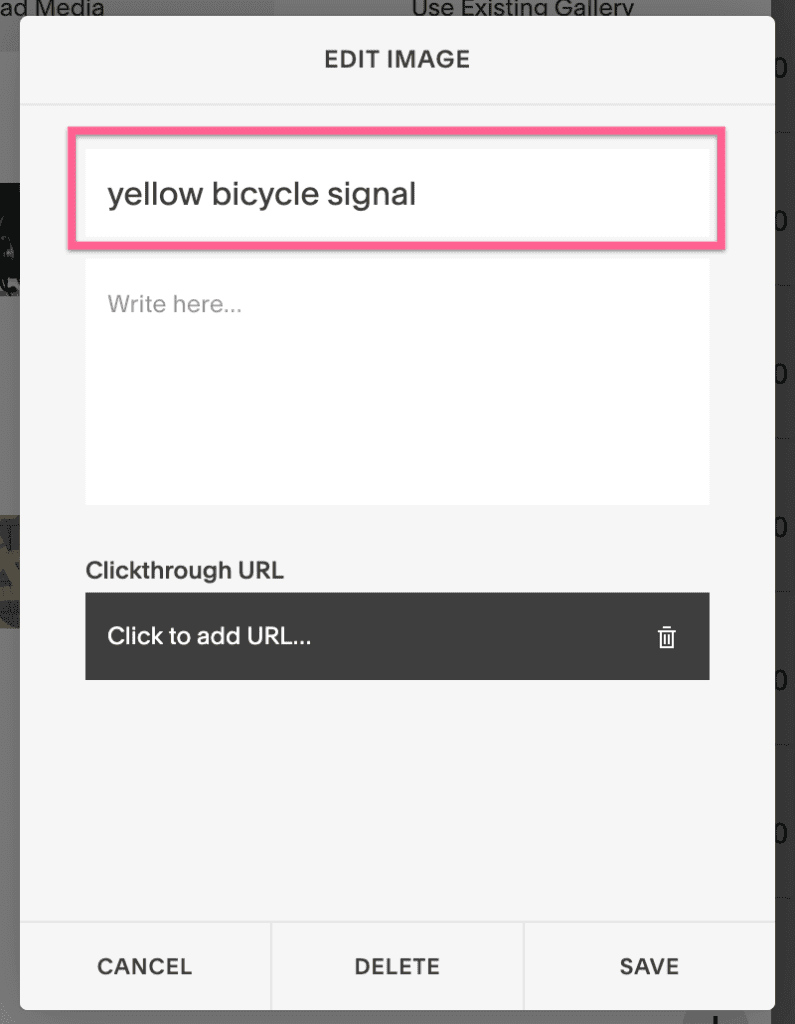
The process to edit image alt text in Squarespace varies depending on the type of image. Here’s a quick tutorial for each image type.
Add Internal Links
When you add a link from “page A” to another on your site, “page B”, that’s called an internal link.
Internal links are helpful for SEO for 3 reasons:
- They can pass some of the SEO value from the homepage or one web page to the other
- They can help Google bots understand the content of a page
- They can help users find other relevant content on your site (increasing engagement)
For example, notice how we link to our page about adding the Facebook Pixel to a WordPress Site inside our Digital Advertising Strategy Guide.
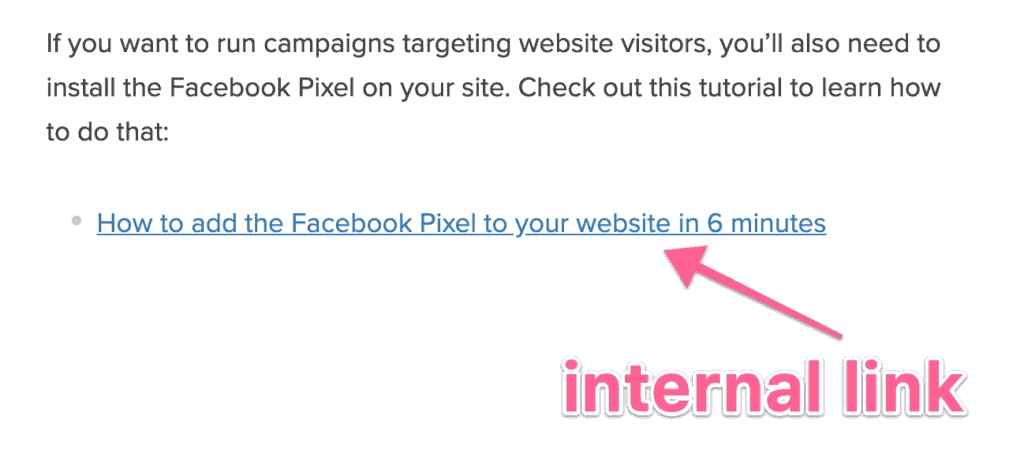
Here are some resources to help you with internal linking:
- Best practices for internal linking
- Anchor Text & SEO: How to Optimize Link Anchor Text for More Traffic
Link Building
Link building is one of the most powerful things you can do to increase your rankings. This is one of the hardest parts of SEO, but there are a few tactics that are proven to work for most websites.
To determine which pages to rank above all others, search engines rely heavily on the authority of pages and websites.
In SEO, authority is mainly determined by links—more specifically, links from other sites to yours.
Here are a few general rules for how the authority is calculated:
- More links > fewer links
- Links from sites relevant to the topic of your site > links from completely irrelevant sites
- Links from sites with high authority > links from sites with low authority
- Links from several sites > several links from a single site
- Links in the body > site-wide links (e.g. header, footer, or sidebar)
These are some tactics you can use to build links to your website site.
Find Unlinked Mentions
Once your business starts being noticed, you’ll often find people including mentions to your business without links.
Just reach out to these people and ask them to include a link along with the mention.
To find unlinked brand mentions:
Start with doing a search for all your current existing unlinked mentions using a tool like ahrefs and reach out to all of those.
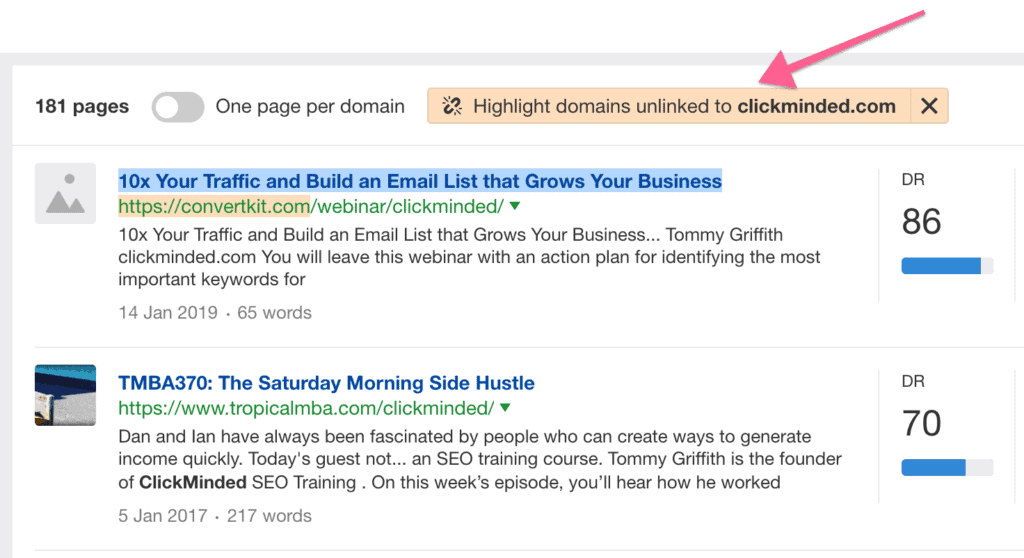
Then, implement alerts on Google Alerts or ahrefs for on-going mentions of your brand (and related terms like your own name or names of products) and reach out to new mentions as they happen.
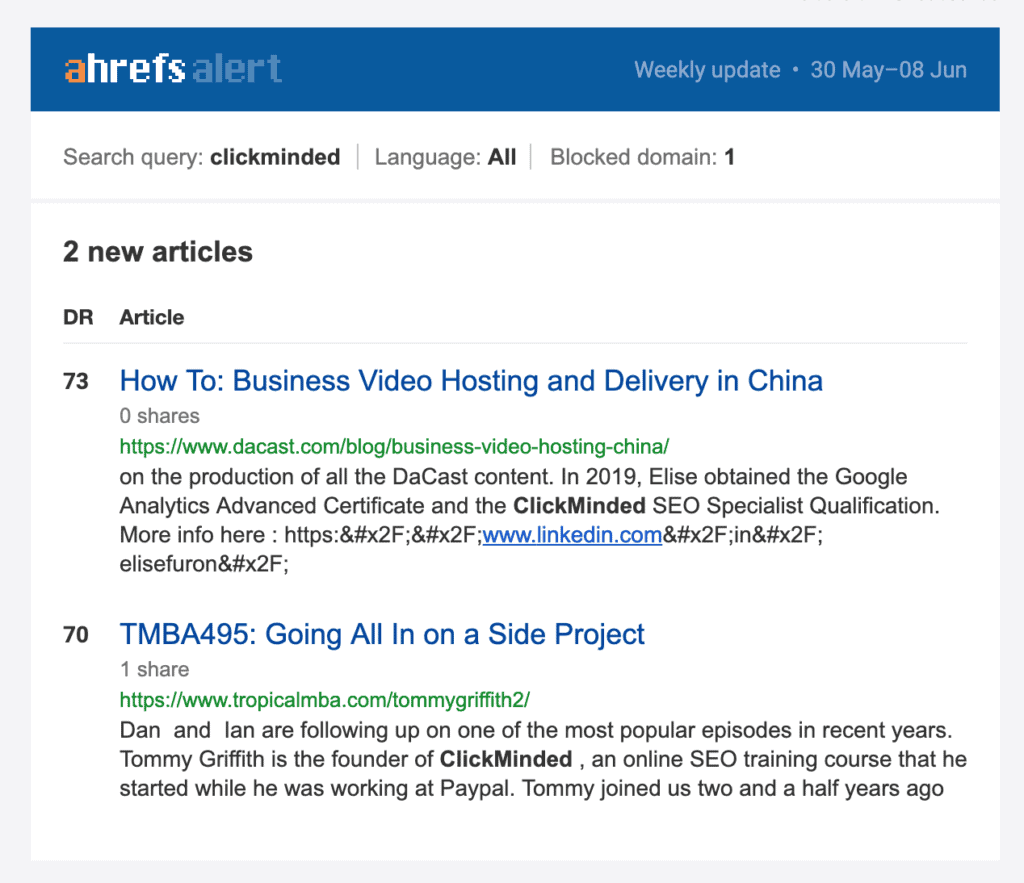
Here are some resources to help you build links from unlinked mentions:
Fix Broken Inbound Links
If your site has been around for a while with no one paying too much attention to SEO…
…you’re going to find broken links.

If the destination of a link returns an error code, that’s a broken link.
From a technical SEO standpoint, it’s a good idea to fix these URLs. But it’s urgent to do this if other websites are linking to those broken URLs.
You can use ahref’s broken backlinks report to find these:
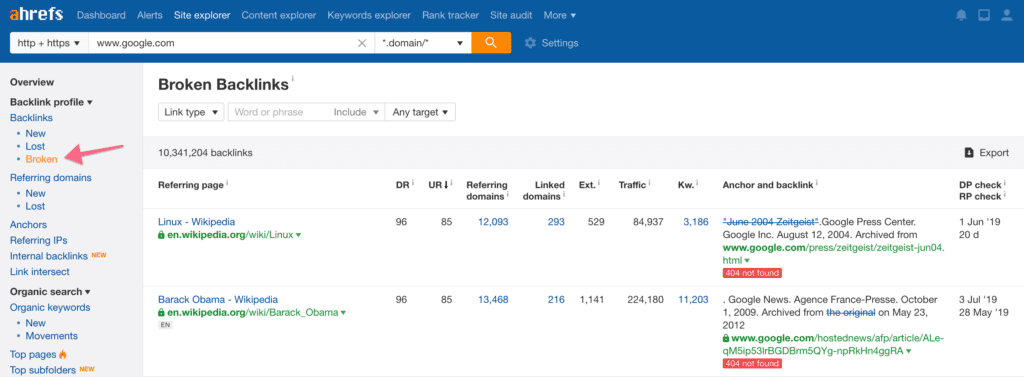
A URL might be broken for several reasons:
- The content was removed
- The content was moved to a new URL
- There is a technical issue
Your options can be:
- Redirect the broken URL to a working URL
- Update or republish the missing content
- Fix the technical issues
Do whatever you need to do to avoid having broken backlinks.
Here are some resources to help you fix broken backlinks:
- How to Find and Fix Broken Links (to Reclaim Valuable “Link Juice”)
- How to create redirects in Squarespace
Guest Post on Relevant Sites
Back in 2014, Google cracked down on spammy guest posting as a link building practice.
Does this mean guest blogging doesn’t work anymore?
No.
If you write valuable guest posts on relevant websites and add links to your site in a natural (not spammy) way, guest blogging can be a great way to build links.
For example, here’s a post we published a while ago on the Moz blog:
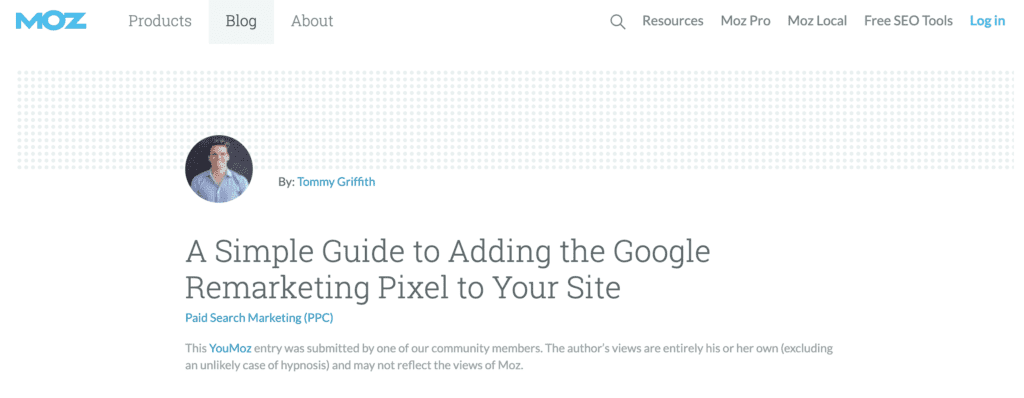
It included a link to this site in the body.

It’s a helpful post, published on a relevant site in my industry, with a non-spammy link to my site. An easy way to find guest posting opportunities is to search Google using advanced search operators.
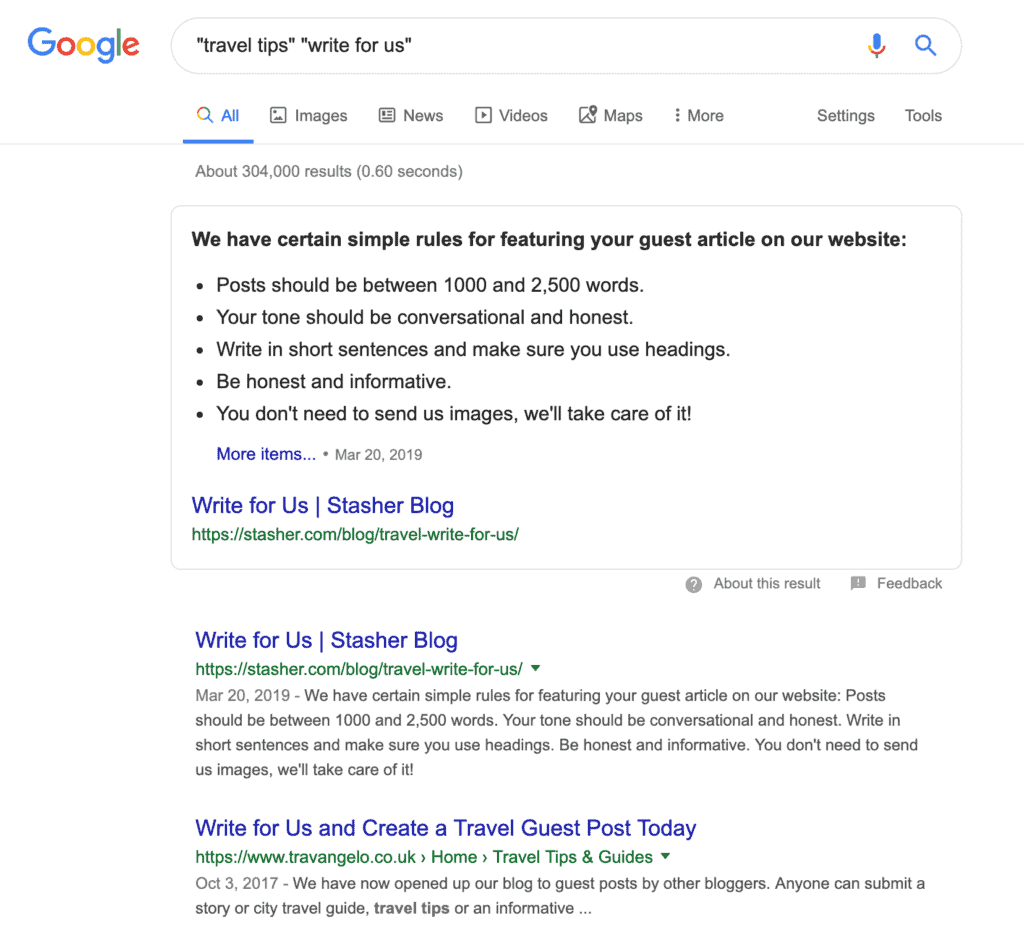
Try these searches for your target keyword:
- “[keyword]” “write for us”
- “[keyword]” “become a contributor”
- “[keyword]” “submit guest post”
- “[keyword]” “guest post by”
- “[keyword]” “guest post”
- “[keyword]” inurl:blog “contributor guidelines”
- “[keyword]” inurl:blog “write for”
Reach out to the blogs or websites that make sense, it may be a good idea to have a few post pitches prepared beforehand.
ProTip: if you have already guest posted on other sites, send over examples along with your pitch to build some credibility.
Here are some resources to help you build links through guest blogging:
- How to Get Massive SEO Intelligence with Advanced Google Search Operators
- Guest Blogging for SEO: How to Build High‐quality Links at Scale
- 17 Guest Posting Tips I Learned From Failing Thousands Of Times
Use Broken Link Building
When other websites don’t fix their broken inbound links (and this happens a lot for larger websites) that’s an opportunity for you.
There are several approaches to finding these broken links:
Approach #1: Use a Chrome extension
You can use a Chrome extension like Check My Links to try to find broken links in pages.
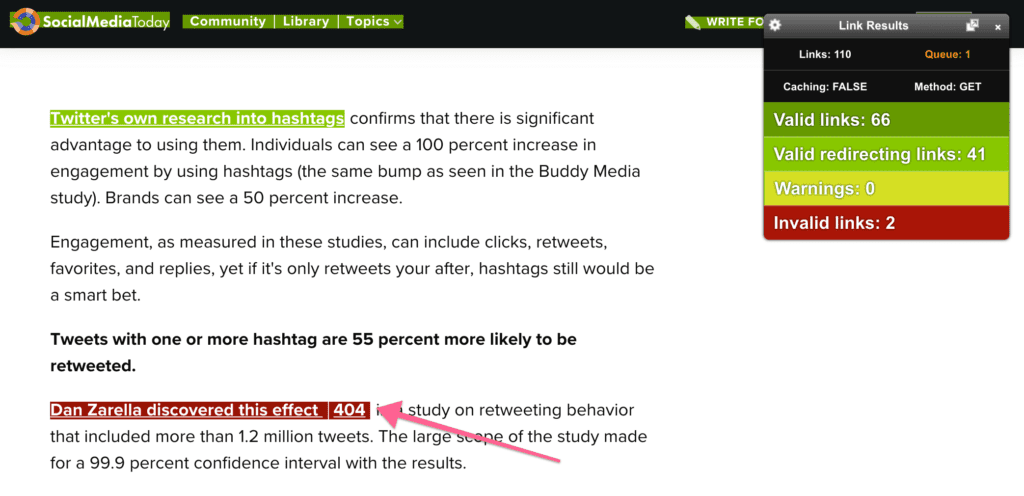
Approach #2: Find broken inbound links to your competitors
Grab your biggest competitors and use ahrefs to find all their broken inbound links.
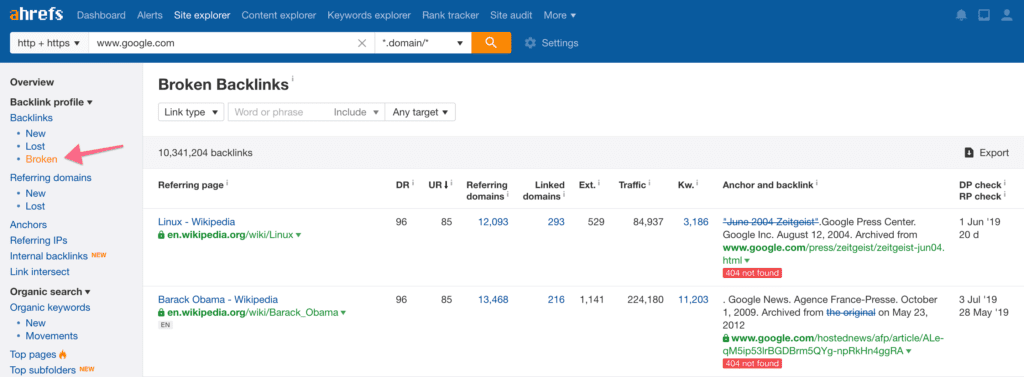
Approach #3: Find broken outbound links on authoritative sites in your niche
If there’s an authoritative website in your niche you want to get links from, you can scrape their site to find broken outbound links.
ahrefs is also a great tool for this, but you can also use something free like Screaming Frog.
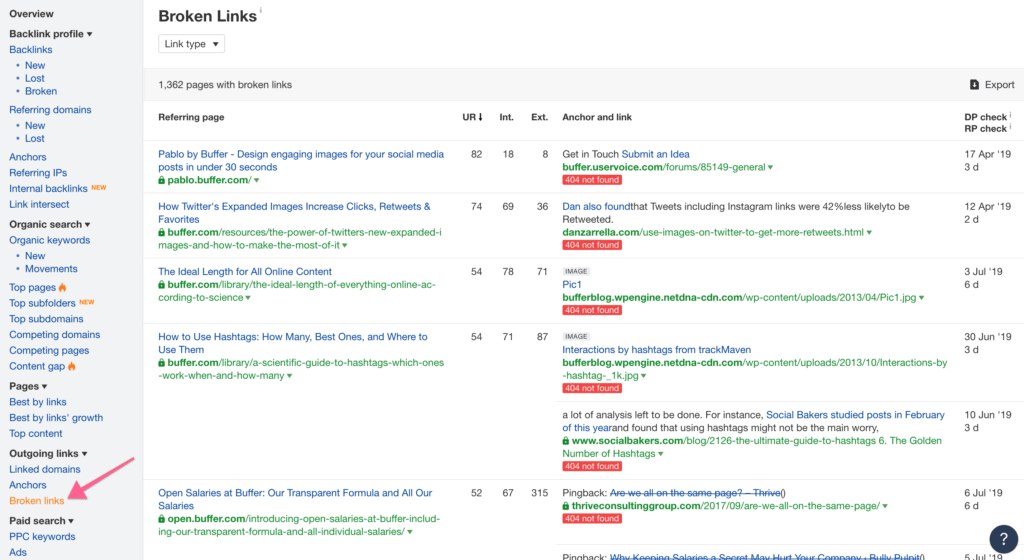
Once you’ve identified the broken links, you need to provide websites with an alternative to link to.
You can use Wayback Machine to find what the content of a broken URL was before it was taken down or removed.
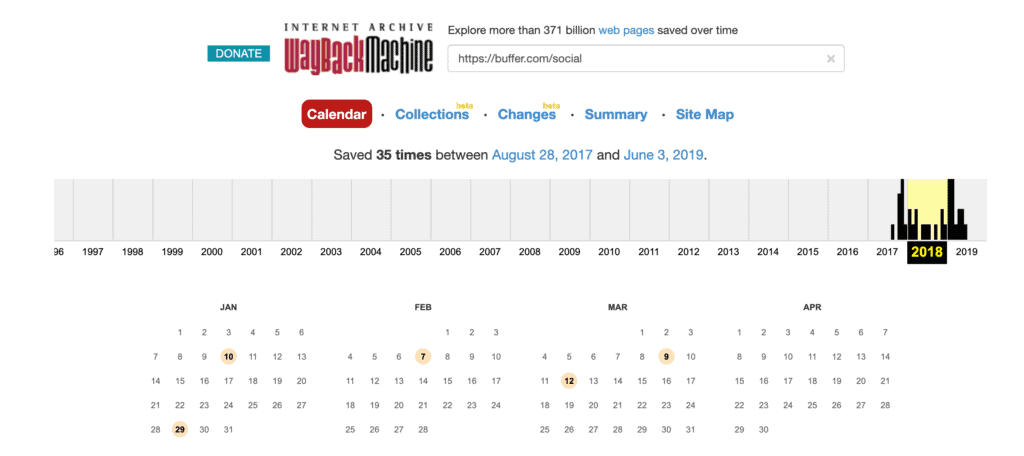
Understand what the content was, create something better or more up-to-date, and reach out to people linking to it letting them know they have a broken link (and you have something they can easily substitute it with).
Technical SEO
Technical SEO is everything you do to make it easier for search engines to find and crawl your website. Technical issues can prevent your site from ranking and getting organic traffic.
Fix Crawl Errors
Crawl errors are those preventing Google from viewing your content correctly.
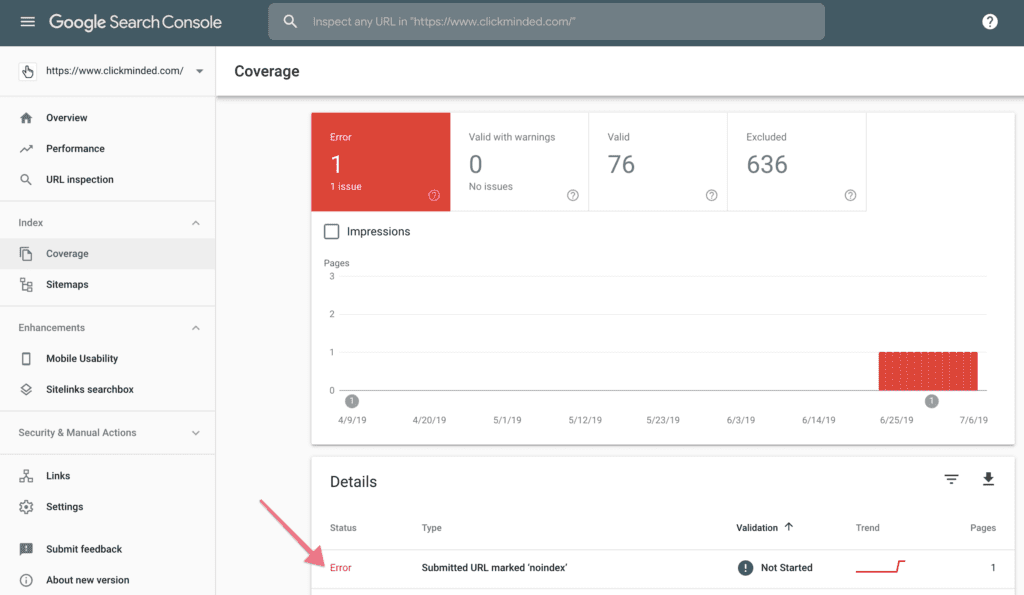
You can find them using the Coverage report in Google Search Console.
Here are great resources on fixing crawl errors:
Use to HTTPS
In an effort to make the web “safer” for users, Google has made a push for more websites to use HTTPS.
So you might see a small ranking boost by switching from HTTP to HTTPS.
Fortunately, Squarespace provides a free SSL certificate for your website once you’ve added your domain.
There’s no need for you to take any action here, but we mention it just because people have asked about it.
Make Sure Your Site is Mobile Friendly
As an increasing amount of web traffic comes from mobile devices, having a site that is not responsive to different screen sizes and shapes will negatively impact usability, especially for local searches.
Plus, Google recently deployed the mobile-first index, which means they’ll use the mobile (not the desktop) version of your site to crawl and index it.
They are basically saying: “If your site isn’t mobile-friendly, it won’t rank highly on Google”.
A responsive theme is one that adapts to any screen size.
All Squarespace sites are built to be responsive, but you can use Google’s Mobile-Friendly Test tool to check your Squarespace site:
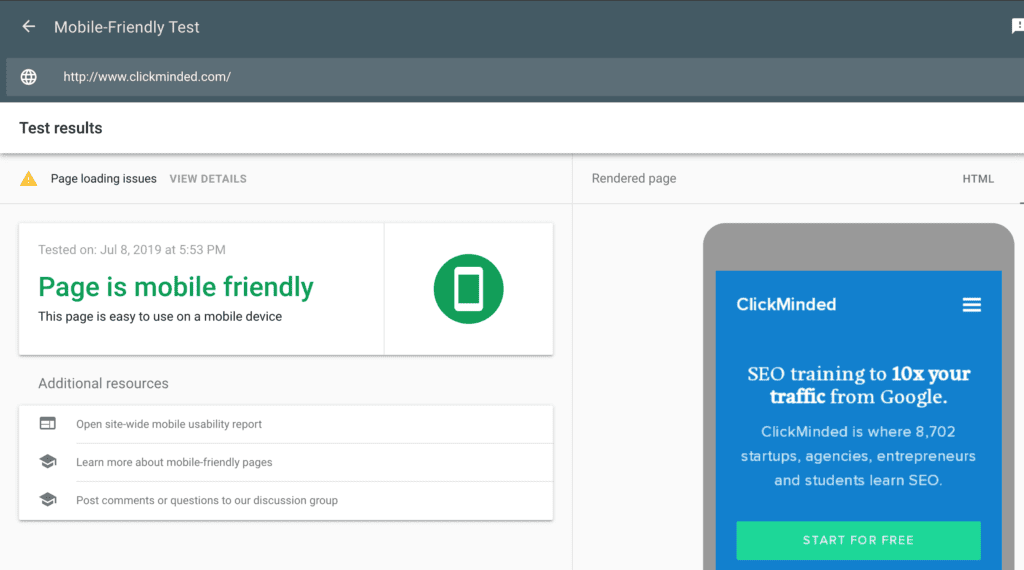
Fix Broken Links
Broken links on your site send a bad signal to Google.
A site with a lot of broken backlinks is probably not up-to-date and unlikely to provide a valuable answer to searchers.
You should try to avoid having broken links on your site.
To find broken links, you can use Screaming Frog or ahrefs.
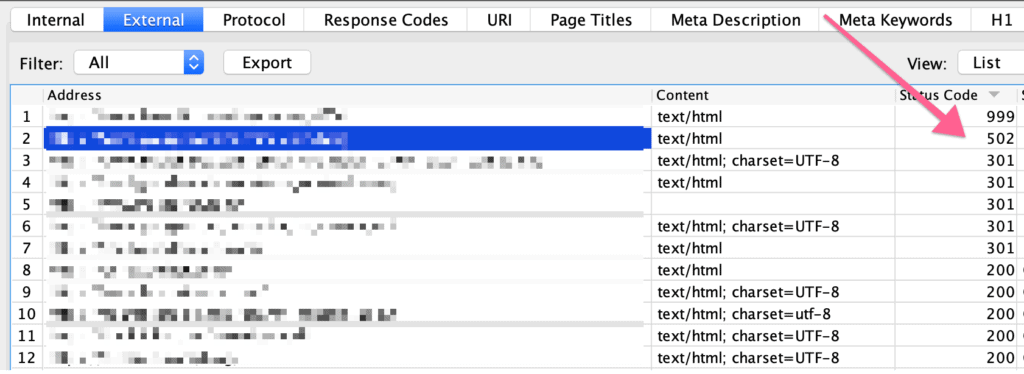
Once you’ve identified your broken links, you can fix the issue by redirecting, updating, or removing the link.
Speed Up Your Squarespace Site
Search engines value sites that provide a good user experience and the speed of your site is a huge factor.
A slow-loading site will increase your bounce rate, as visitors lose patience and leave.
Many tools offer speed tests along with suggestions on how to make your site faster—some of the ones we like are Google’s PageSpeed Insights, GTMetrix, Pingdom.
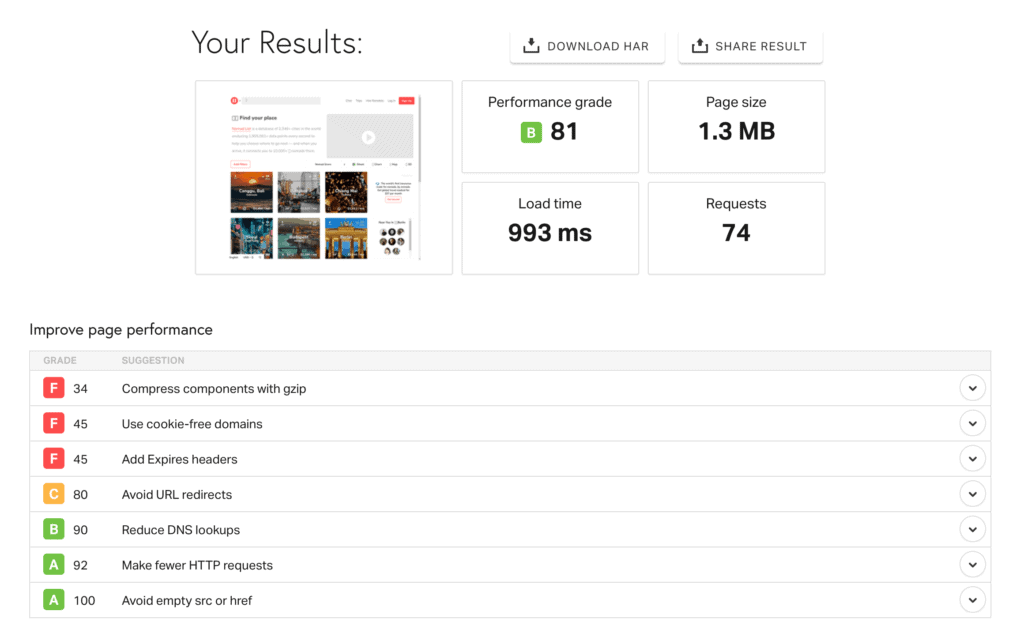
ProTip: It’s super easy to get caught up in trying to fix all of these speed issues and getting a perfect score. DON’T do this—in general, these are things you can do to improve the speed of your Squarespace site:
- Compress and reduce the size of your images—high-quality images are great, but most of the times you don’t need a 40MB image that’s 4000×6000 pixels.
- Uninstall apps you’re no longer using.
Submit Your Sitemap to Google Search Console
An XML sitemap helps search engines understand the structure of your site and find all the pages that you want to be indexed.
Squarespace automatically creates and updates your website’s sitemap for you—you can find it at www.yourdomain.com/sitemap.xml
Then, you can use Google Search Console to submit your sitemap to Google:
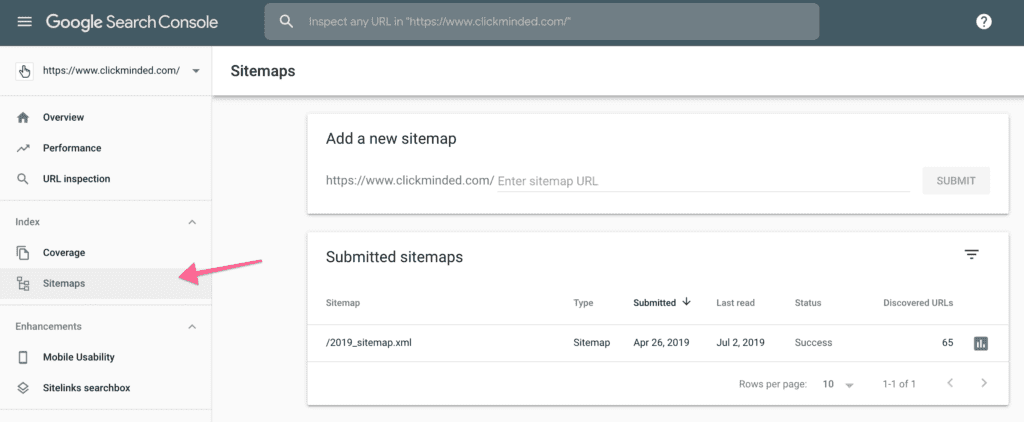
Tracking & Monitoring
These are some extra tips you might want to check out now that you’ve gone through the rest of the items on this Squarespace SEO checklist.
Set Up Rank Tracking
Whenever I start working on an SEO project, one of the first things I do is set up rank tracking.
Doing this will allow you to easily monitor your website’s rankings among dozens or hundreds of keywords.
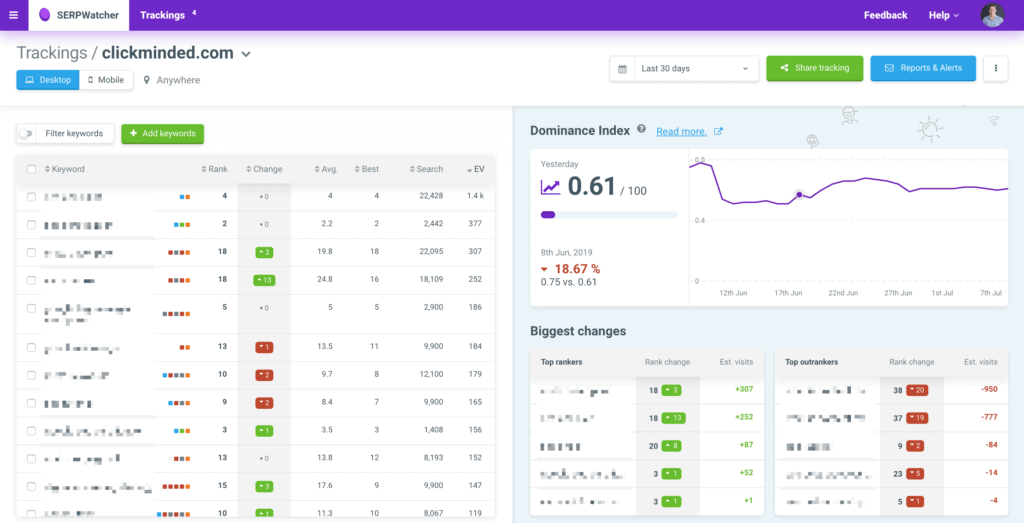
Tracking your rankings lets you know whether your efforts are paying off.
These are the tools I like for rank tracking:
- SERPWatcher
- ahrefs (although you might have to pay extra if you want your rankings to be updated daily)
Claim Your Brand Name on as Many Social Networks as Possible
For reputation management reasons, not only do you want to make sure no one else gets your account name, but you can often own all the results on the first page of a search for your brand if you’re a new website or company.
You can use NameChk to help with that.
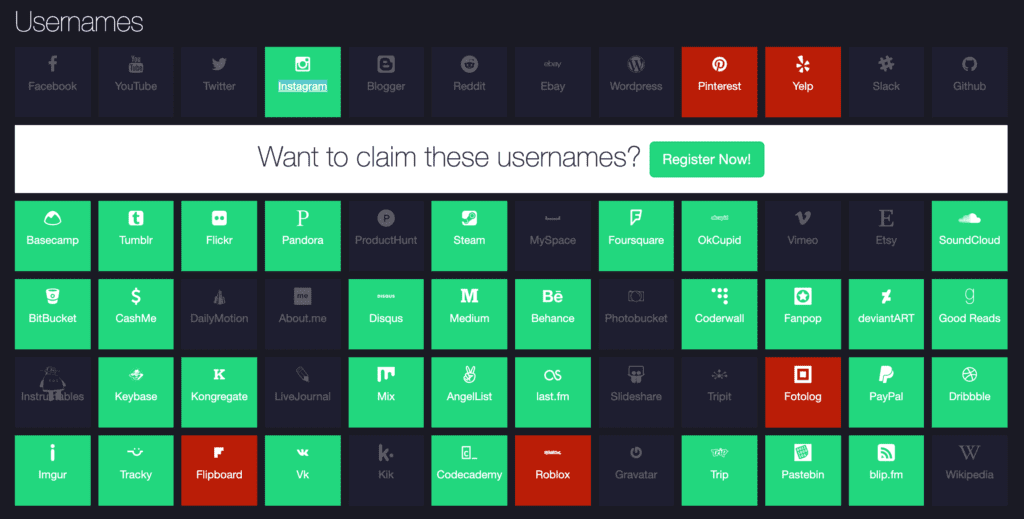
Set Up Alerts
This was already covered in the link building section, but we recommend setting up Google Alerts or ahrefs alerts for mentions of your brand and products.

This way, you can be the first to know when someone’s talking about your company or brand and respond accordingly.
In Conclusion
This should be everything you need to get going optimizing your Squarespace website for search engines.
If you’re looking for even more digital marketing resources, try a few of these:
Earn Your SEO Certification
ClickMinded offers an SEO training course that teaches you exactly how to increase traffic to any website, as quickly as possible.
The course includes a final exam. Take the course, pass the final exam, and you’ll earn your SEO certification. It integrates seamlessly with LinkedIn.
ClickMinded certifications are designed to show future employers and clients that you understand how search engine optimization fundamentally works. We also have a digital marketing certification and a social media marketing certification.
Sidenote: we are very open about the fact that certifications don’t mean that someone is good at SEO (or digital marketing)—but some people still want them for various reasons, so we offer them.
Boost the Impact of Your SEO Efforts With Other Marketing Channels
SEO works best when combined with other channels.
If you’re just getting started on digital marketing or want to learn more about how to get more traffic and sales from other marketing channels, check out our free strategy guides:
- Digital Marketing Strategy Guide
- Sales Funnel Strategy Guide
- Content Marketing Strategy Guide
- Email Marketing Strategy Guide
- Paid Advertising Strategy Guide
- Social Media Strategy Guide
- Website Analytics Strategy Guide
Some other SEO Checklists that you can check out are:
You can also check out the Clickminded SEO SOP toolkit to get step-by-step instructions for your SEO campaigns.